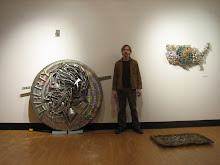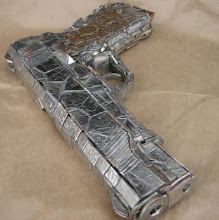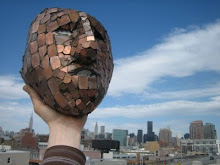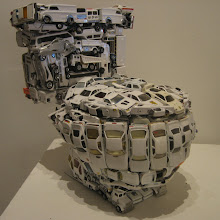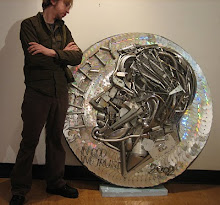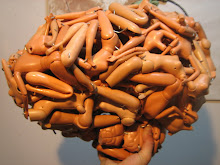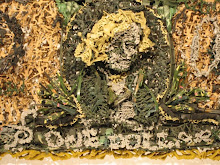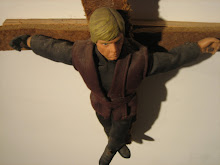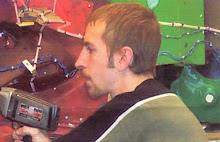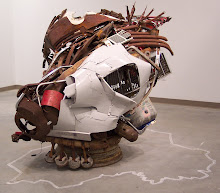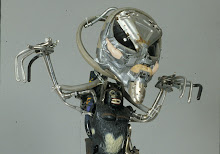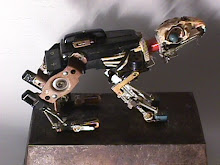Of all the doodads and gizmos that our species has created, perhaps none has been so important as the camera. With its invention comes truth: actual captured reality. Whereas before it simply continued, a moment could now be frozen for all to see later: the past proving itself to the future. This was big.

In the last century, 0ur explorations of the power of the lens to freeze time have evolved drastically. The brilliant minds that spawned the first kernels of the photographic process knew that something powerful and important could be harnessed, yet it's highly unlikely they had any notion how grand and sophisticated the whole thing would eventually become.

Back in 1996, when I was 20 years old, I too was convinced that I had stumbled upon a powerful and important idea. The idea was to become an artist, and disregard the common path.

Using a 35mm camera my parents had purchased in the 70's, I captured my young image in the mirrors on the bathroom medicine cabinet. This was a period of dramatic decisions and constant questioning. For all practical purposes, I was insane at the time.

I say this because my choice to cast everything in life aside in order to pursue only art was crazy.

This was a time in my life when I should have been preparing for my future. I could have chosen to become anything whatsoever: I was, after all, going to college. I had a great aptitude for math, and an interest in science, yet when I started taking studio art classes, I realized where I truly wanted to focus. An art degree? I was nuts.

Nobody but me could understand the brilliance of the decision, but my mind was made up. The rest of my options shriveled up, and I began to feed one alone. The choice was not smart financially speaking, but that seemed unimportant. I was an artist, and I embraced it.

Now I realize I was correct, and the choice is one I respect completely. Basically, since then, I've never stopped working on art. What I put into motion has evolved in many ways, and back then I could never have envisioned the new creations I see unfolding before me today, 13 years later.

Truly, that mad minded young man was a genius, destined for greatness. My respect for him is immense, even if I do consider him naive. He could never have imagined where his efforts would lead, yet he trusted that he wouldn't fail. I feel obligated not to let him down. I want to prove he wasn't crazy.

When I made a camera from chopped coins and epoxy, I put a New York Quarter in the viewfinder. "Gateway to Freedom", reads the text, and the Statue of Liberty is superimposed over the outline of New York State. Your typical Times-Square tourist is crossed with an Astronaut: a bizarre hybrid indeed.

This work serves as homage to the great minds that developed the process of photographic reality absorption, who made it possible for the people of the past to merge their moment with the future.

As time continues, a moment can seem endless, yet when captured, it becomes succinct. Bravo! What an impressive invention.

Creating this object from money immortalizes its intrinsic attachment to the modern, capitalist era. Would the camera have come to be if there had not been a strong desire to create multiple images quickly to distribute for profit? Didn't the visionaries who envisioned replacing painters by taking photographic portraits of the wealthy elite pave the way for their own paths to riches? Surely for some, this was the mindset, yet many, most likely, had a greater interest in discovery than dollars. They just wanted to be able to figure out how to take pictures, mostly because they realized that to be able to do so would be really freeking cool. To them, this was bigger than money: this was history.

These, I'd be willing to wager, were the ones who brought the majority of the advances. It seems like the true geniuses rarely let profit motivate them in their pursuits, driven instead by a desire to see the completion of an idea only they can grasp. The profiteers are a secondary player, driven only by the idea of money.

Say Cheese!
 I was promoting a new kind of artwork I had created to describe the election. This was the first time I had ever made a mosaic, and my medium was chopped coins.
I was promoting a new kind of artwork I had created to describe the election. This was the first time I had ever made a mosaic, and my medium was chopped coins. This piece was shared heavily online, and I moved on to develop more work from the same materials. It's hard to believe the difference a year can make.
This piece was shared heavily online, and I moved on to develop more work from the same materials. It's hard to believe the difference a year can make. Now, after being stored privately for the last 12 months, I bring this historic piece of art back into the public arena, in the heart of Manhattan, to a new pub on the border of Chelsea and the West Village.
Now, after being stored privately for the last 12 months, I bring this historic piece of art back into the public arena, in the heart of Manhattan, to a new pub on the border of Chelsea and the West Village. The work, "Obama Vs McCain", will be on display indefinitely, as will "Wall St. Stop", which was the 2nd work I made using chopped coins.
The work, "Obama Vs McCain", will be on display indefinitely, as will "Wall St. Stop", which was the 2nd work I made using chopped coins.























































